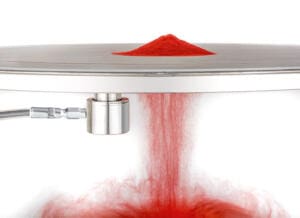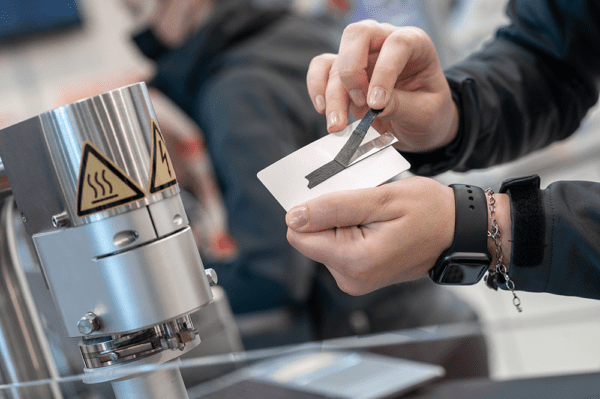
Ultrasonics and Electromobility – A Synergy for Success
Ultrasonic-based processes are already recognised for their efficiency, performance capability, reliability, connectivity and eco-friendliness. These characteristics are also mirrored by electric vehicles, providing a close synergy between the two, and positioning ultrasonic technology as the ideal solution to many of the manufacturing tasks associated with vehicle production.
Electromobility is transforming the way we travel, by significantly reducing emissions of carbon dioxide per kilometre when compared to vehicles powered by conventional combustion engines. Also, the increasing levels of energy produced from renewables such as wind and solar not only support the transition to electromobility, but also helps further reduce pollution levels overall.
The increasing demand for electric vehicles is, however, presenting the automotive industry with new challenges in many areas including lightweight body construction, the manufacture of electrical and electronic components, and of course the batteries needed to power these vehicles. Innovative and economic production solutions will be required if the automotive manufacturers are to maintain the highest quality levels and retain the environmental credentials associated with electromobility.
Efficient – Ultrasonic sieving in battery production
If the performance figures quoted for electric vehicles are to be accurate, close scrutiny needs to be applied to the efficiency of all aspects including the battery, drive train, air resistance and the rolling resistance of the tyres.
If the end product itself is to be efficient, the individual manufacturing processes also need to be conducted most efficiently. This is where Telsonic’s ultrasonic sieving process plays a key role in the earliest stages of battery production. Sieves stimulated by ultrasonics reduce friction during the separation of powdered battery materials. This reliable and energy-efficient process technology improves selectivity and therefore provides the homogeneous powder consistency required for manufacturing the electrodes used in vehicle batteries.
Using ultrasonically stimulated double-decker sieves, with precisely defined mesh sizes, allows the carbon for the anode and the lithium metal oxide for the cathode to be separated with a high degree of selectivity, with incorrect sizes reliably removed. These quality characteristics are essential for subsequent processes where the powder is mixed into a paste with water and solvent and must be applied to the electrode carrier films in an extremely homogeneous way.
Powerful – reliable contacting of high-voltage conductors, battery films and high-performance electronics
Just like the electric motors used in battery-powered vehicles, which are able to provide full power from startup, ultrasonic processes are also ready to deliver the highest levels of performance exactly when you need them, keeping cycle times to a minimum.
The cables and plugs that connect the charging station with the high-voltage battery require a reliable connection with low contact resistance to achieve rapid charging. This can often require efficient welding of copper, aluminium or any combination of the two to produce the high-voltage connections used in vehicles.
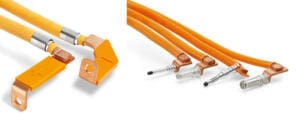
Here, a cable with a cross-section of 70, 95 or 120 mm² must be securely welded to a high-current contact, with designers demanding a weld width that is as narrow as possible to save space. What was previously difficult to achieve using conventional processes can now be easily accomplished using Telsonic’s PowerWheel® technology to quickly and reliably connect the cable to the high-current contact.
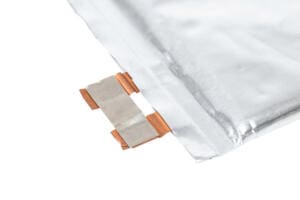
In other applications, the contacts between the individual aluminium and copper films of the pouch cells of a high-voltage battery, and the arresters for the external connections, are welded quickly, reliably and with consistently high quality using ultrasonics.
Another of Telsonic’s ultrasonic processes, this time SONIQTWIST®, is used to produce IGBT power semiconductors, which are capable of switching electrical currents quickly with minimal losses, and a key electronic component for power converters of electrical drives and battery charging systems. This unique torsional welding technique, which uses slim sonotrodes that approach from above, is particularly suitable for the sensitive ceramic substrates of the IGBTs onto which the contacts are welded.
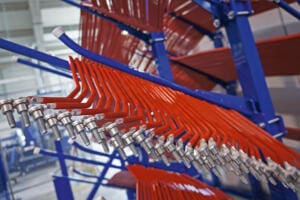
SONIQTWIST® is also perfect for cylindrical welding applications. Rotationally symmetrical sonotrodes can be used for round bolts, rings or screws, a technique which is not possible with any other process. For example, this process allows automotive suppliers to weld a steel bolt pressed into a copper-nickel sleeve to the front end of an aluminium busbar as a contact. In this case, the weld is made without any interruptions, a full 360° around the sleeve. This provides short cycle times and high productivity when integrated into a fully automated system.
Reliable: Wire splicing for electrical connections
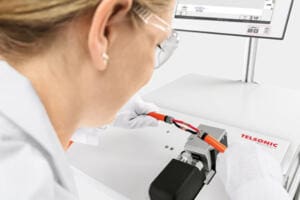
Electric vehicles have fewer moving parts, which significantly reduces maintenance costs and increases reliability. Ultrasonic welding systems are also extremely reliable and low-maintenance. Wire splicing using ultrasonics is, therefore, the solution of choice whenever reliable electrical connections are required to achieve the high-quality standards demanded by the automotive industry. Cable connections must be perfect to function reliably throughout the life of a vehicle.
In applications such as this, connections produced using the ultrasonic process deliver both financial and technical advantages. These include a straightforward and cost-effective process, low electrical contact resistance, and high strength in the area of the conductor material. A range of extremely flexible welding systems is available to support various production requirements. This means that even very thin cables with a cross-section of 0.13 mm2 and twisted cables for high data transfer rates can be welded using Telsonic’s ultrasonic technology.
Connected: Integrated in a higher-level production system
Today’s electric vehicles are highly digital and make full use of their connectivity features. The optimum route can be calculated based on the battery charge level, individual driving style, traffic and other environmental conditions along the route.
Ultrasonic processes can also be designed and digitally optimised to suit any specific application. The ability to adjust and monitor the relevant process parameters in an application-specific manner ensures high levels of reliability and safe operating practices when using ultrasonics for wire splicing tasks.
The control and operating software used in Telso®Splice welding systems provides integration and networking options that are fit for the future, together with numerous functions for effective quality assurance. Telsonic’s wire splicing systems can be connected directly to production management systems, giving users a significant amount of added value. This primarily applies to 4Wire CAO by DiIT / Schleuniger, the most popular MES in the sector. However, integration with other MES systems is also simple and intuitive using the flexible Telso®CON interface. A level of automation up to 100% is possible, thanks to the OPC UA architecture, process control and parameter configuration of our intelligent benchtop systems.
Eco-friendly: Joining technology for lightweight construction
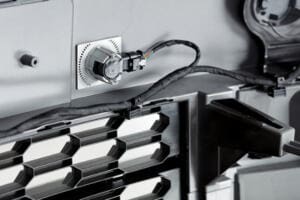
Ultrasonic technology is also playing an increasingly important role in lightweight automotive construction. This is an area where new materials and thin-wall technology can benefit directly from SONIQTWIST® ultrasonic welding technology. This patented and gentle welding process makes it possible to significantly reduce the wall thickness of vehicle bumpers (to approx. 2 mm) without leaving visible marks on the opposite pre-painted Class-A surfaces. Ultrasonic technology is, therefore, making a significant contribution to reducing the weight of vehicles. The fact that no adhesives or other consumables are required eliminates any adverse impact on the environment from the joining process.
The clear synergies between electromobility and ultrasonic processes mean that they will continue to be closely linked, as automotive manufacturers strive to not only increase the efficiencies of the vehicles that they produce, but also leverage from the efficiencies of the technologies used to manufacture them. The many benefits which can be derived from ultrasonic processes can be both highlighted and best realised by engaging with ultrasonic specialists at an early stage in the design process.
Telsonic Ultrasonics
+44 (0)1202 697340
Website
Email
